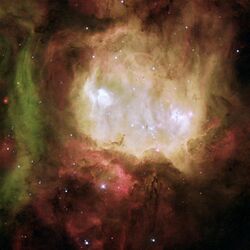Astronomy:NGC 2080
| Emission nebula | |
|---|---|
 | |
| Observation data: J2000.0 epoch | |
| Right ascension | 05h 39m 44.2s |
| Declination | −69° 38′ 44″ |
| Distance | 160,000 ly |
| Constellation | Dorado |
| Designations | ESO 057-EN012, h 2950, GC 1278 |
NGC 2080, also known as the Ghost Head Nebula, is a star-forming region and emission nebula to the south of the 30 Doradus (Tarantula) nebula, in the southern constellation Dorado. It belongs to the Large Magellanic Cloud, a satellite galaxy to the Milky Way, which is at a distance of 168,000 light years.[1] NGC 2080 was discovered by John Frederick William Herschel in 1834.[2] The Ghost Head Nebula has a diameter of 50 light-years[3] and is named for the two distinct white patches it possesses, called the "eyes of the ghost".[4] The western patch, called A1, has a bubble in the center which was created by the young, massive star it contains. The eastern patch, called A2, has several young stars in a newly formed cluster, but they are still obscured by their originating dust cloud.[1][4] Because neither dust cloud has dissipated due to the stellar radiation, astronomers have deduced that both sets of stars formed within the past 10,000 years.[4] These stars together have begun to create a bubble in the nebula with their outpourings of material, called stellar wind.[5]
The presence of stars also greatly influences the color of the nebula. The western portion of the nebula has a dominant oxygen emission line because of a powerful star on the nebula's outskirts; this colors it green.[4] The rest of the nebula's outskirts have a red hue due to the ionization of hydrogen.[4] Because both hydrogen and oxygen are ionized in the central region, it appears pale yellow; when hydrogen is energized enough to emit a second wavelength of light, it appears blue, as in the area surrounding A1 and A2.[1][4]
NGC 2080 should not be confused with the Ghost Nebula (Sh2-136) or the Little Ghost Nebula (NGC 6369).
See also
References
- ↑ 1.0 1.1 1.2 Wilkins, Jamie; Dunn, Robert (2006). 300 Astronomical Objects: A Visual Reference to the Universe (1st ed.). Buffalo, New York: Firefly Books. ISBN 978-1-55407-175-3.
- ↑ Frommert, Hartmut; Kronberg, Christine (19 April 2006). "More LMC objects". SEDS. http://messier.seds.org/xtra/ngc/lmc_more.html.
- ↑ Nemiroff, R.; Bonnell, J., eds (31 October 2001). "Halloween and the Ghost Head Nebula". Astronomy Picture of the Day. NASA. https://apod.nasa.gov/apod/ap011031.html.
- ↑ 4.0 4.1 4.2 4.3 4.4 4.5 "Hubble Sends Season's Greetings from the Cosmos to Earth". HubbleSite. NASA and ESA. 19 December 2001. http://hubblesite.org/newscenter/archive/releases/2001/34/.
- ↑ "Painting with oxygen and hydrogen". ESA. 18 October 2001. http://www.spacetelescope.org/news/heic0114/.
External links
- NGC 2080 on WikiSky: DSS2, SDSS, GALEX, IRAS, Hydrogen α, X-Ray, Astrophoto, Sky Map, Articles and images
- SEDS
- Hubble Sends Season's Greetings from the Cosmos to Earth – Hubble Space Telescope news release
- NASA Astronomy Picture of the Day: Halloween and the Ghost Head Nebula (31 October 2001)
- Release on NGC 2080 at ESA/Hubble
Coordinates: ![]() 05h 39m 44.2s, -69° 38′ 44″
05h 39m 44.2s, -69° 38′ 44″
 |

